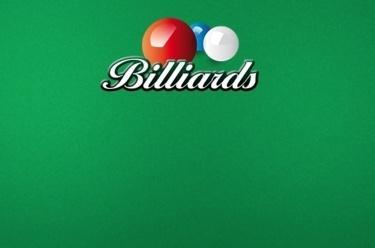
Pool
Game rules
Basic principle
The playing field consists of the pool table. The pool table is equipped with 'pockets' in every corner as well as along the long side of the table where the balls can be potted. You can determine at what point you are going to play a selected ball with the cross-hairs on the right side of the field.
The balls are hit with so-called cues (match sticks). If you click on the cue ball with your mouse the cue appears. Before that a yellow line with an image of the cue ball is visible. It shows you the direction of the shot. If you press and hold down the left mouse button you can position the cue in the desired direction. An arrow appears which will show the force of the pool shot by changing its length. The shorter the arrow the weaker the shot. If you release the mouse button the white ball will be played.
Game play 8-ball pool
All balls on the pool table with the exception of the white ball ('cue ball') are placed in the shape of a triangle. The number of balls that still have to be potted are displayed in the top left corner.
If you have started the round on this table you have to leave the break to your opponent. The white ball will be shot into the triangle of coloured balls. At the start of the game, at least four coloured balls have to touch the cushion or one ball has to land in a pocket otherwise you have violated the rules.
The first ball that is potted determines, which colour balls you play. The players will then try in turns to pot their balls with the help of the white ball. If you pot a ball it is your turn again.
Fouls 8-ball Pool
The following moves count as a violation of the rules:
- Pocketing of the white ball
- Not striking any balls or a ball of your opponent
- Premature pocketing of the black ball
- Invalid break (see start of the game)
- If no coloured ball is pocketed or touches the cushion with the first stroke.
If a player commits a foul his opponent can move the white ball anywhere on the table and continue the game. The player who pots the black ball prematurely has lost the game.
If all balls of a particular colour have been pocketed the black ball has to be sunk in a certain pocket to finish the game. This pocket is indicated by a coloured circle.
End of the game 8-ball Pool
The player who pockets all seven balls of his colour and finally the black ball correctly wins the game. A game ends in a draw if neither player is able to pot a coloured ball after 20 shots.
Game play 9-ball Pool
At the beginning, nine coloured balls lie in a diamond shape on the pool table. The fouls are counted in the top left of the pool table. Alongside it is an indication of the ball that must be played next.
The player who has started the new game starts first by breaking. The white ball is then aimed at the coloured balls. At the start of the game, at least four coloured balls have to touch the cushion or one ball has to land in a pocket otherwise you have violated the rules. In contrast to the rest of the game, this is the only play where it does not matter which balls are sunk.
Alternately, the balls are now to be sequentially sunk into the pockets, beginning with the number 1. If a player pots the right ball, it’s their go again. Throughout the game there are some breaches of the rules that are counted as fouls.
Fouls 9-ball Pool
- Pocketing of the white ball
- Not hitting a ball or playing the wrong ball
- Potting the incorrect ball
- Invalid break (see start of the game)
- If no coloured ball is pocketed or touches the cushion with the first stroke.
After a foul, the fouled player may place the cue ball anywhere on the table. If a player commits a foul by sinking the wrong ball, it is counted as a foul, but the ball is not placed on the table again, unless it is the 9-ball. If a player commits three fouls in a row, the game ends in favour of the fouled player.
Pushout
A special game option is the so-called pushout. It can be activated at the start the game right after the break by any player who did not break. Should a player choose a pushout, they are not obliged to play the next lowest ball, but can hit any ball. This is not considered a foul, except for when the white ball is also pocketed. The pushout can especially help you when the balls are in a particularly tricky position after the break.
End of the game
Regardless of who has sunk how many balls in the game, the game ends with the potting of the number 9 ball. Whoever sinks it at the end, wins the game.
Game play Snooker
The snooker table is slightly larger than the classic pool table. In addition, a white line and a semi-circle (D-zone) are located in the left first third. The points are calculated in the top left. In addition, instructions appear above on whose turn it is next.
The balls are placed in a special starting position in snooker. All of the red balls are formed into a triangle positioned at the right side of the table, and the yellow, brown and green ball are placed along the line drawn. The blue ball is positioned in the middle of the table. The pink ball is placed at the apex of the triangle, the black ball sits behind the triangle, centrally aligned to the baseline. The black, pink, blue and brown ball form a straight line.
When breaking, the cue ball must be placed anywhere within the D Zone.
Shot by shot you need to pot a red ball followed by a coloured ball that is previously announced.
Fouls Snooker
The following moves count as a violation of the rules:
- Sinking the white ball (higher value of either ball intended or ball that was hit, at least four penalty points)
- Playing the wrong ball (value of ball intended, at least four penalty points)
- Not striking any balls
- Potting the wrong ball (higher value of either the intended ball, the ball that was hit or the ball that was potted, at least four penalty points)
If a foul is committed, the points go to the fouled player, who may then continue. Should the white ball be potted here, it must be placed anywhere in the D zone to continue. If a player can not hit a red or, towards the end of the game, a coloured ball after a foul, they can either continue to play or allow the opponent to continue.
If a coloured ball is sunk at the wrong time, this ball, unlike the red balls, is placed back to its original position on the table. Should this position be blocked, the next possible free space is selected. Once all the red balls have been pocketed, the coloured balls are then pocketed in ascending order of their score of 2 to 7. Unlike earlier in the game, they will no longer be reinstated in their original position, but remain in their pockets.
End of the game Snooker
The game is over once all the red and coloured balls are pocketed. The player who collects more points, wins. In the case of a tie, the black ball is reinstated. The next points won or lost decide the game.




